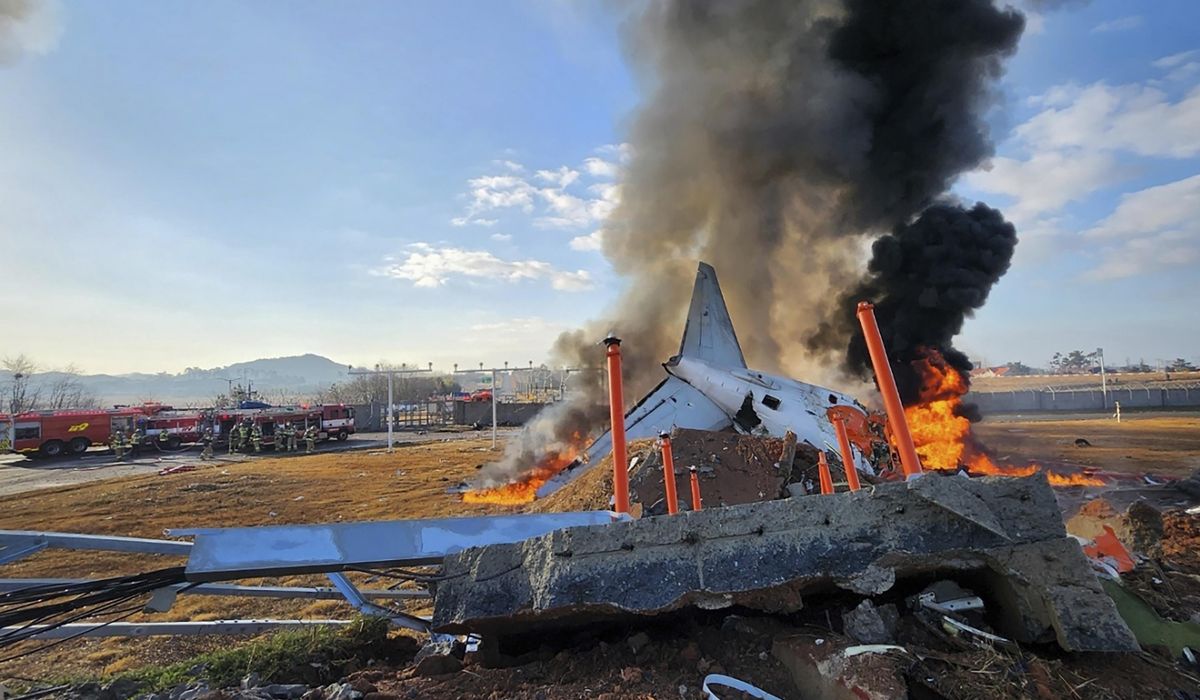


SEOUL, South Korea | An airliner carrying 181 people crashed Sunday morning in South Korea, killing at least 176 of those on board.
Authorities said there were two survivors and three people missing from Jeju Air Flight 7C 2216 from Bangkok, Thailand, which crashed at 9:07 a.m. at Muan International Airport, about 180 miles from Seoul.
The cause of the Boeing 737-800 jetliner’s fiery crash was being investigated. Two separate issues — a bird strike to one jet engine and a failure to deploy landing gear — have been noted by flight data and video recordings by people on the ground.
Those onboard were South Korean, as well as two Thai nationals.
Jeju Air is Korea’s leading low-cost airline, mostly providing travel to and from the vacation island off Jeju, as well as regional routes.
Korean media reported a press briefing offered by the Ministry of Land, Infrastructure and Transportation.
Per the briefing, the Muan control tower issued a warning of a flock of birds in the air space at 8:57AM. One minute later, Flight 7C 2216 declared mayday and attempted to land from the opposite end of the runway, with the tower’s permission.
Disaster occurred on the aircraft’s second attempt to touch down.
The fast-unfolding tragedy is visible in footage shot by persons near the airport.
An apparent bird impact to the aircraft’s starboard jet intake was caught in a video recorded from the ground as the plane passed overhead. The clip was shared by Korean news and then circulated widely on social media.
Visually, the strike causes a minor blast in the wake of the plane, but not a major explosion, nor a fire.
Other videos recorded from the ground show the aircraft hurtling along the runway on its belly without its landing gear deployed. Smoke, but no flame, is seen pouring from the starboard engine.
In decontrol and at high speed, Flight 7C 2216 careens off the runway and into a concrete barrier, explodes into a fireball, and disintegrates.
Emergency crews were immediately on hand, but all imagery shows a scene of devastation with wreckage scattered far and wide.
The two survivors — both crew members with serious injuries, now hospitalized — were reportedly in the tail section. That appeared recognizably intact, though upside down and scorched.
Shocked family members gathered at the airport, where some berated media for filming their misery.
South Korean Acting President Choi Sang-mok on Sunday visited the airport and declared Muan County a special disaster zone, meaning it can receive state support.
“The government is allocating all available resources,” Mr. Choi said. “We will thoroughly investigate the cause of the accident.”
Impeached President Yoon Suk Yeol broke his silence to send condolences. He is awaiting a constitutional court hearing on his impeachment, which was voted on by parliamentarians after he declared martial law on Dec. 3.
One tragedy, two problems, no answers
The aircraft’s black box flight recorder has reportedly been discovered, but not yet analyzed, as investigations are pending.
Multiple questions are, at this early stage, unanswered.
The Boeing 737-800, a twin-engined aircraft, is capable of flying on one engine, meaning a single bird strike should not have been catastrophic.
A question being posed in multiple open source intelligence and aviation fora on social media is why the undercarriage was not lowered, given that it would be extremely unusual for an engine failure to impact hydraulics or landing gear.
An American pilot who has flown in southern South Korea, writing on a closed, security-related online chat group seen by Washington Times, stated: “A bird strike may take out an engine but not landing gear.”
Related protocols exist to deal with landing gear issues.
“If for some reason, [a pilot’s] landing gear does not deploy, he would want to circle the airport while making multiple attempts to deploy the gear, while getting input/guidance from flight engineers on the ground,” the source wrote.
If there is no resort but a belly landing, the pilot would usually dump fuel to reduce likelihood of fire, while emergency services would spray the runway with foam, he suggested.
No foam is evident in any of the footage.
The aircraft destroyed in the Sunday incident had made an emergency diversion two days prior, while en route to Beijing.
“We can confirm that yesterday, December 27, 2024, the Boeing 737-8AS (Registration HL8088) involved in today’s accident declared an emergency and diverted to Seoul,” X account AirNav Radar, which tracks flights globally, wrote, citing flight data and a flight path map.
However, that emergency had been due to a passenger’s medical condition, not to any technical issue with the aircraft.
Boeing, the aircraft’s manufacturer, which has suffered from a string of safety issues in recent years, stated that it is in contact with the airline.
“We are in contact with Jeju Air regarding Flight 2216 and stand ready to support them,” the firm wrote on X. “We extend our deepest condolences to the families who lost loved ones and our thoughts remain with the passengers and crew.”
In a remarkable coincidence, a Canadian aircraft crash landed at Halifax Aircraft just hours later.
Faulty landing gear was cited as the cause of the Air Canada Express flight, which crashed at 9:30PM Canada-time, at Halifax Airport.
Though footage shot from inside the aircraft shows an alarming blaze on the aircraft’s port side, no serious injuries or fatalities were reported in the incident.
The Canadian aircraft was a much smaller De Havilland than the Boeing involved in the Korean crash.
• Andrew Salmon can be reached at asalmon@washingtontimes.com.
